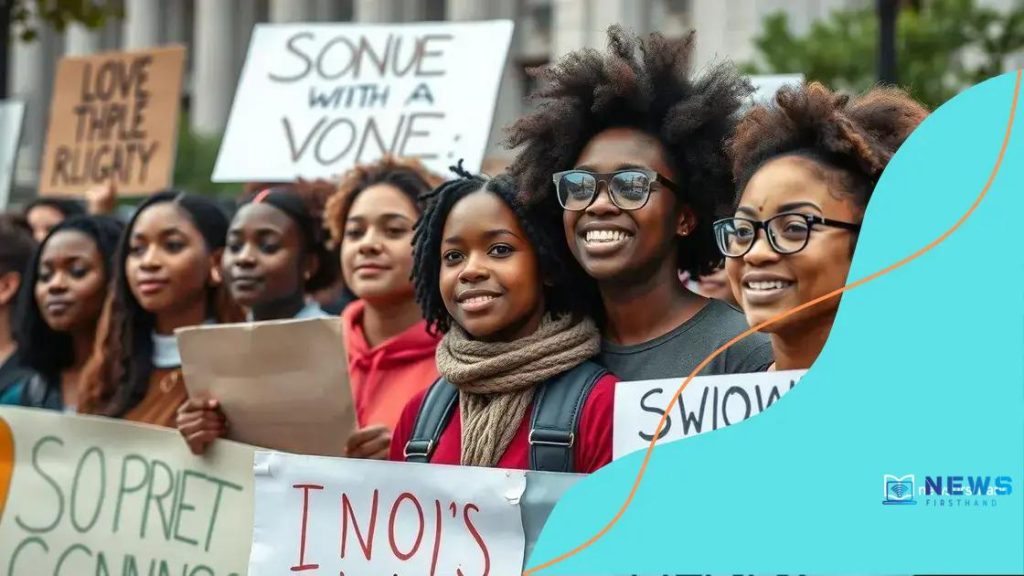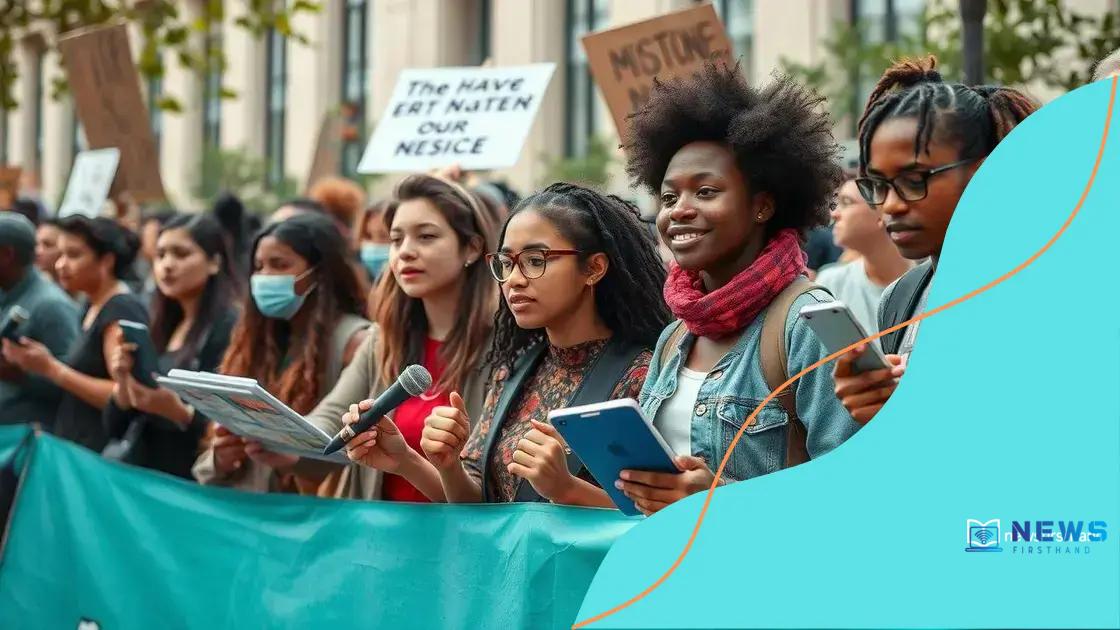Youth-driven civil rights campaign: sparking change today

Youth-driven civil rights campaigns utilize technology, social media, and innovative strategies to advocate for social change, amplifying their voices and influencing policy decisions while fostering inclusivity and global awareness.
Youth-driven civil rights campaign movements are redefining the landscape of social justice. But have you noticed how the voices of younger generations are echoing louder than ever in our society? Join me as we dive into this powerful phenomenon.
the historical context of youth activism
Understanding the historical context of youth activism is essential to appreciate its impact today. Over the decades, young people have stood at the forefront of pivotal social movements, advocating for change and justice. From the civil rights movement to modern climate strikes, youth voices have shaped the narrative.
The Civil Rights Movement
During the 1960s, teenagers and young adults became crucial players in the civil rights movement. Their energy and passion sparked significant change. Many young activists participated in protests, sit-ins, and marches, demanding equal rights.
- Formation of the Student Nonviolent Coordinating Committee (SNCC).
- Role of college students in organizing marches.
- Iconic events, like the March on Washington.
These actions were not just about the fight for equality; they also showcased the influence of youth as change-makers. This legacy continues to inspire new generations.
Anti-war Protests
Another landmark moment for youth activism occurred during the Vietnam War. Young people protested against the draft, propelling the anti-war movement. They used creative methods to voice their dissent, including music, art, and rallies. This showed how youth could unite for a cause.
Many remembered the famous slogan “Make Love, Not War,” which encapsulated the spirit of the time. This activism revealed a generation willing to challenge authority and fight for their beliefs.
Modern Youth Movements
As we look into the present, it’s clear that the legacy of youth activism continues. Today’s teenagers are leading movements for climate justice, gun control, and more. Organizations like March for Our Lives and student-led climate strikes demonstrate their commitment.
- Rallies and organized protests.
- Utilizing social media for mobilization.
- Collaboration with established advocacy groups.
By understanding the historical context, we see a continuum of activism that showcases the resilience and determination of youth in confronting the challenges they face.
key figures in the youth-driven civil rights movement
Throughout history, many key figures in the youth-driven civil rights movement have emerged as powerful symbols of change. These individuals have inspired countless others to take a stand for justice and equality.
John Lewis
One of the most prominent leaders was John Lewis. As a young activist, he played a vital role in organizing marches and speaking out against segregation. His bravery during the Selma to Montgomery marches showcased his commitment to nonviolent protest.
- Co-founder of the Student Nonviolent Coordinating Committee (SNCC).
- Speaker at the March on Washington.
- Continued advocacy for civil rights throughout his life.
His voice resonated with young people and motivated them to join the fight for equality.
Diana Nash
Diane Nash was another influential figure. As a college student, her passion for justice led her to organize sit-ins and protests against discriminatory business practices. Her leadership helped to elevate the role of women in the movement, proving that youth could mobilize effectively.
She encouraged her peers to fight back against oppression, sparking a wave of activism across campuses.
Rosa Parks
Rosa Parks, while known for her pivotal role in the Montgomery Bus Boycott, also inspired youth. Her courageous refusal to give up her bus seat catalyzed a surge in youth-led activism, as young people rallied behind her message of resistance.
Students were motivated to challenge the status quo, leading to organized marches and awareness campaigns.
Currently Emerging Leaders
In recent years, young figures have continued to rise. Activists like Emma Gonzalez and Greta Thunberg have gained attention for their roles in advocating for gun control and climate justice. These contemporary leaders show that the spirit of youth activism remains strong.
The examples of both past and present key figures reveal the ongoing influence of youth in the struggle for civil rights. Their stories inspire the next generation to continue the fight for justice and equality.
strategies and tactics used by youth activists

Youth activists have employed various strategies and tactics throughout history to advocate for change. Their creativity and determination have led to significant social impacts. Understanding these approaches helps us see how young people have shaped the civil rights movement.
Nonviolent Protests
One of the most effective tactics has been nonviolent protests. Young activists often organize peaceful demonstrations to showcase their demands. Sit-ins and marches are key examples. These actions allow them to draw attention to issues without resorting to violence.
- Historical sit-ins at segregated lunch counters.
- Marches, like the one in Washington for civil rights.
- Organized rallies for climate justice.
By using nonviolent methods, youth activists create a clear message that resonates with the public and media.
Social Media Mobilization
In today’s world, social media is a powerful tool. Young activists utilize platforms like Twitter, Instagram, and TikTok to spread awareness and gather support. This approach helps them connect with wider audiences and mobilize quickly.
For example, hashtags like #NeverAgain and #FridaysForFuture have sparked global movements. Furthermore, social media allows for real-time updates, enabling activism to grow rapidly.
Peer Education and Workshops
Another strategy involves peer education. Youth activists often conduct workshops and discussions to educate their communities about social issues. They empower others to take action by providing tools and knowledge.
- Organizing local seminars on civil rights history.
- Hosting workshops on how to register voters.
- Creating informative content about climate change.
By sharing knowledge, they inspire more individuals to become involved in activism, ensuring a broader impact.
Art and Creative Expression
Art is also a vital tactic. Many young activists use music, poetry, and visual arts to convey their messages. Artistic expression can reach people on an emotional level and promote empathy.
From protest songs to powerful murals, creative works often inspire action and foster connections between individuals involved in the movement. This approach not only raises awareness but also revitalizes the spirit of activism.
impact of social media on campaigns
The impact of social media on campaigns has been profound, especially for youth-driven movements. With platforms like Twitter, Instagram, and Snapchat, young activists can share their messages faster and reach a wider audience than ever before.
Instant Communication
Social media allows for instant communication. Activists can quickly spread information about upcoming events, rallies, and initiatives. This immediacy helps mobilize support and foster engagement among followers.
- Event announcements can go viral in minutes.
- Updates and important news reach audiences instantly.
- Engagement through comments and shares boosts visibility.
By harnessing this power, campaigns can gain traction quickly, drawing more participants and supporters.
Building Community
Another significant impact is the ability to build communities. Online platforms allow individuals with similar goals to connect. This sense of belonging encourages participation and collective action.
Groups and pages focused on specific causes foster discussions, share resources, and provide encouragement. Young activists find strength in knowing they are part of a larger movement.
Amplifying Voices
Social media amplifies diverse voices in the movement. Authentic stories shared online resonate with audiences, showing the personal stakes involved in activism. This can be especially powerful when addressing issues like gun violence or climate change.
- Personal narratives humanize the cause.
- Increased visibility for marginalized groups.
- Greater representation in discussions around social issues.
By telling their stories, youth can inspire others to join the fight for social justice.
Challenges and Risks
Despite the benefits, there are challenges. Misinformation can spread easily on social media. Activists need to be vigilant about the information they share. Additionally, online harassment can pose significant risks to those involved in activism, especially young people.
Despite these challenges, the role of social media in amplifying campaigns and connecting individuals remains crucial. By utilizing these platforms wisely, youth activists can continue to effect change and inspire others.
the future of youth-driven advocacy
The future of youth-driven advocacy holds great promise. As young people continue to engage in social issues, their influence grows stronger. They are not only shaping the conversation but also paving the way for new solutions.
Embracing Technology
With the rise of technology, youth activists are leveraging various digital tools to amplify their messages. They use platforms to create powerful campaigns that reach audiences worldwide. This trend is expected to continue, making advocacy more interactive and impactful.
- Increased use of virtual reality to simulate experiences.
- Online petitions garnering global support.
- Innovative apps for mobilizing community actions.
These developments allow for greater participation and engagement, making advocacy efforts more effective.
Awareness of Global Issues
Younger generations are increasingly aware of global issues. Climate change, social justice, and mental health are just a few areas where they are active. This global perspective will shape the future of youth-led initiatives.
As young people recognize their interconnectedness, they form alliances across borders. This collaboration enriches the conversation and drives collective action.
Policy Influence
Another important aspect is the growing influence of youth on policy decisions. More young people are running for office or joining political groups. Their participation ensures that their voices are directly heard in legislative processes.
- Youth councils advising local governments.
- Increased youth representation in political parties.
- Engagement in decision-making forums.
This trend promises to bring fresh perspectives to longstanding issues, creating policies more reflective of youth needs.
Creating Inclusive Movements
Lastly, the future of youth advocacy aims to be more inclusive. Activists work towards ensuring that all voices are heard, especially those historically marginalized. By fostering diversity, movements become stronger and more resilient.
Young activists recognize the power of unity and collaboration. They encourage dialogues that celebrate differences and promote understanding across various communities.
\n
| Key Insights | Details |
|---|---|
| 🌍 Global Awareness | Young activists are increasingly aware of global issues, fostering collaboration across borders. |
| 📱 Tech Utilization | Advocates use technology for campaigns, enhancing outreach and participation. |
| 👥 Inclusive Movements | Efforts are made to ensure diverse voices are represented in advocacy initiatives. |
| 🗳️ Policy Impact | Youth are increasingly influencing policy decisions and running for office. |
| ✨ Bright Future | The future looks encouraging for youth advocacy as they continue to rise and inspire. |
\n
\n
FAQ – Frequently Asked Questions about Youth-Driven Advocacy
How are youth activists influencing social issues today?
Youth activists are using technology and social media to raise awareness and mobilize support, making significant impacts on social issues.
What role does social media play in youth advocacy?
Social media allows young activists to communicate instantly, build communities, and amplify their messages to a broader audience.
Why is inclusivity important in youth-driven movements?
Inclusivity ensures that diverse voices are represented, making movements stronger and fostering solidarity among different communities.
What is the future outlook for youth advocacy?
The future looks bright as young people increasingly engage in policy-making and collaborate on global issues, driving change effectively.





